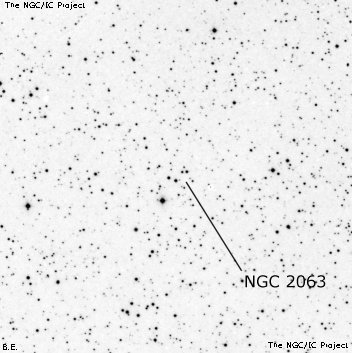NGC/IC Project Restoration Effort
(This is a very very beta version)
NGC2063


Basic Information
Location and Magnitude
Right Ascension: 6:32:42.0
Declination: +8:48:53
Constellation: ORI
Visual Magnitude:
Historic Information
Discoverer: Herschel W.
Year of discovery: 1783
Discovery aperture: 18.7
Observational
Summary description: Cl, poor, S sc st
Sub-type: *Grp
Corwin's Notes
=====
NGC 2063. When I looked at this in 1997, I wrote:
[This] may be the small grouping of 7-8 faint stars at WH's place, though
there is another larger clump with brighter stars about 8 arcmin to the
south-southeast. Neither is likely to be a true cluster, and I am not sure
that either one is the correct object. Taking WH at his word, though, I've
tentatively assigned the NGC number to the stars at his place.
JH did not see this clump, but mistakenly asigned the number H VIII 2 to
h 366 (= NGC 2039, which see) in his 1833 catalogue. He separated the two
objects for the GC, and Dreyer followed his lead.
The second paragraph is still appropriate early in 2014, but I now feel that
the southeastern clump of stars is the correct one. What has changed my mind
is having reduced WH's position (8m 28s preceding, 1deg 16 arcmin north of "58
(alpha) Orion" = Betelgeuse). This has moved the position nearly four arcmin
south of the NGC position (which comes from GC) toward the southern clump of
stars. That "cluster" of fainter stars has no outstanding "members" -- unlike
the northern one -- so more closely matches WH's brief description: "A S cl
of vS sc sts."
While I don't think we can be sure of this identification, the fact that it
is closer to both WH's position and description than the northern clump -- it
also looks more like an eye-catching cluster than the northern clump --
suggests that it is what WH saw.
-----
In June 2016, I found the entry for this in Archinal and Hynes, but at
05 43 55, +08 39.8 (J2000), nearly three minutes of time west of WH's
position. Brent adds the notes, "Skiff: Not obvious in 0.4 degree field.
Archinal: 9' scattered group centered on small Milky Way patch. On W[est]
side of NGC 2039." As we'll see below, there is no evidence at all that NGC
2063 is west of NGC 2039 (which see). I do not know how Brent came to this
position (it is not from his Webb Society Monograph No. 1), but it cannot
apply to NGC 2063, so I've rejected it.
WH claims to have two observations of this cluster, but digging into the
sweeps in Herschel Archive, I found the following (the reduced positions
follow WH's descriptions):
26 Dec 1783: 32:: min following, 52:: arcmin north of mu Orionis.
A small cluster of scattered stars.
06 34 18, +08 36.9 (J2000)
28 Dec 1785: 8m 28s preceding, 1 deg 16 arcmin north of alpha Orionis.
A few pretty closely scattered very small stars.
05 46 48, +08 43.0 (J2000)
WH assigned the same serial discovery number, "21" to both of these clusters
even though the positions leave them nearly a dozen degrees apart. I do note,
however, that the December 1783 sweep (Sweep 67)was done during WH's very
first observing season when he had not yet worked out a satisfactory method of
finding positions. There are only four objects in that sweep: mu Orionis
itself, NGC 2063, NGC 2251, and NGC 2261. WH also observed NGC 2251 and NGC
2261 on 28 December 1785; his positions for those two objects from the 1783
sweep are in better agreement, but are still not up to his later standards:
NGC 2251 26 Dec 1783: 06 36 15, +08 08.3
28 Dec 1785: 06 34 29, +08 21.5
(Modern: 06 34 41, +08 21.5)
NGC 2261 26 Dec 1783: 06 39 18, +08 42.4
28 Dec 1785: 06 39 05, +08 45.1
(Modern: 06 39 10, +08 44.7)
I tried looking at offsets to NGC 2063 from both of the other objects, but
found nothing more convincing than the southeastern clump of stars I noted
above. Given that WH's positions for the latter two objects are more or less
in agreement with the modern positions, I do not think that he misidentified
his single star on 26 December 1783. But his observation of his number 21 on
that night remains a mystery. While there are random clumps of stars within
30 arcminutes of his position, none are particularly convincing as "A small
cluster of scattered stars."
So this leaves us with only WH's second observation as a guide to NGC 2063.
This is the one that JH ultimately adopted for the GC. He offers us no
explanation there as to why he separated his observations (h 366 = NGC 2039)
from his father's VIII 2, but it was probably based on simple caution given
the discordant positions and descriptions.
Steve's Notes
=====
NGC 2063
18" (1/26/09): although nothing stands out in the field, near William Herschel's position is a group of 30 stars elongated N-S in a string. Includes mag 10.1 HD 247555 near the north end, though the richest concentration is at the south end (7' S from the bright star).
Other observers have picked brighter groupings in the area as NGC 2063 and WH's description of "a small cluster of very small scattered stars" is not very helpful. RNGC classifies the number as nonexistent and in any case this number likely applies to an asterism and not a true cluster.



